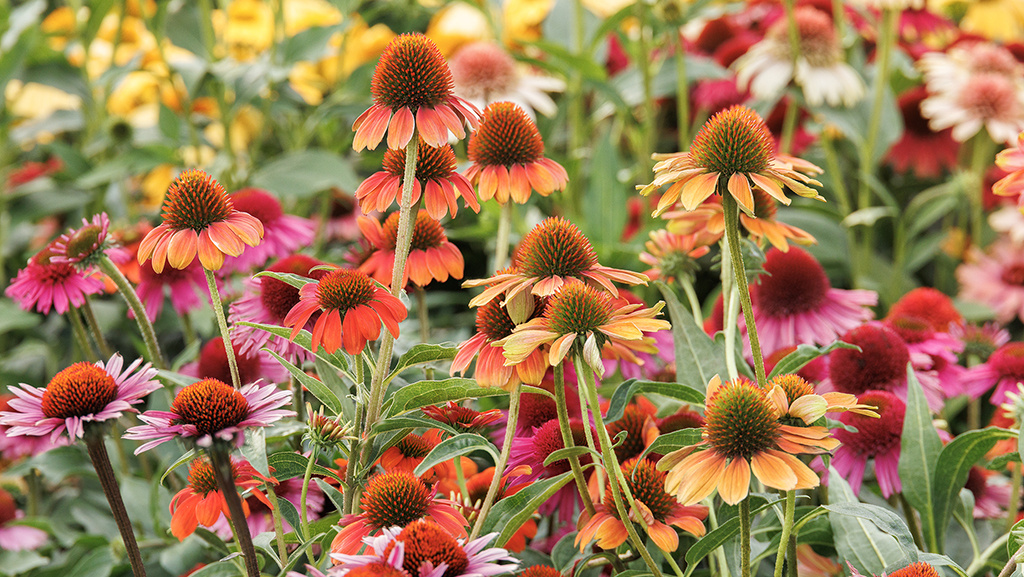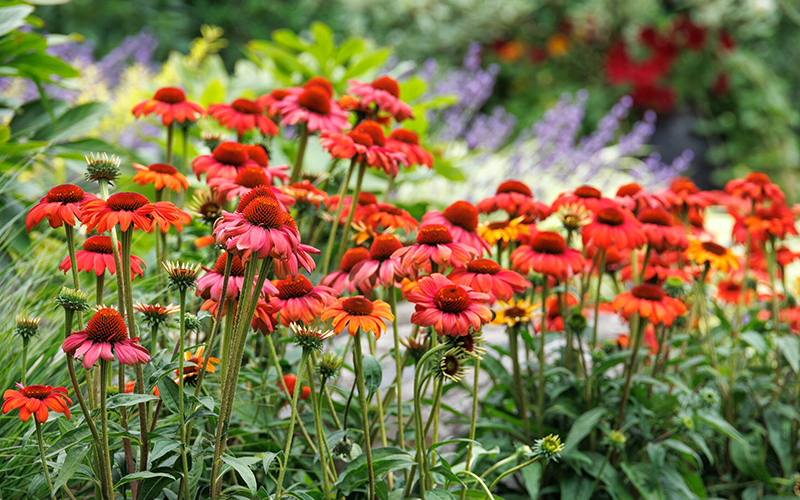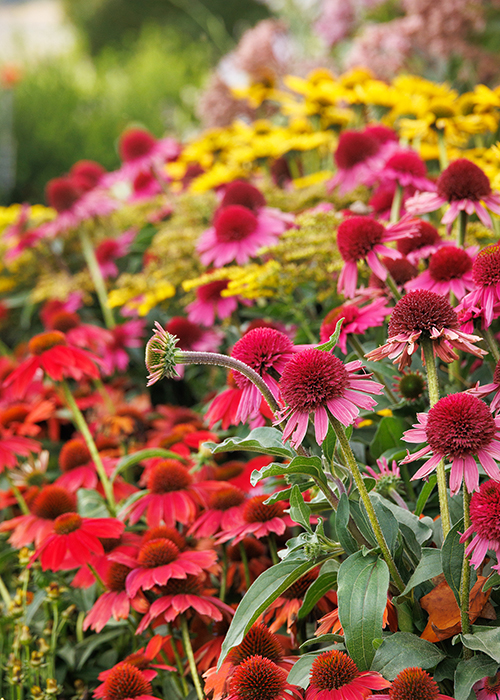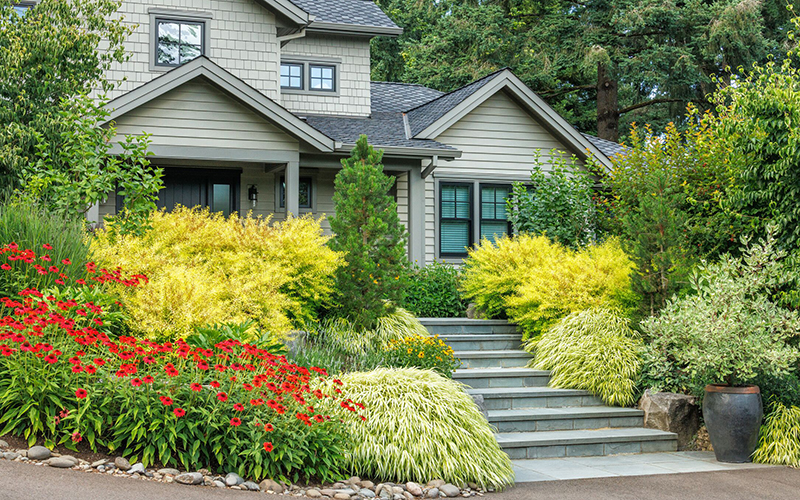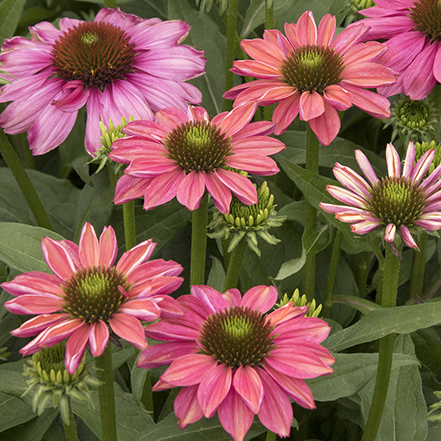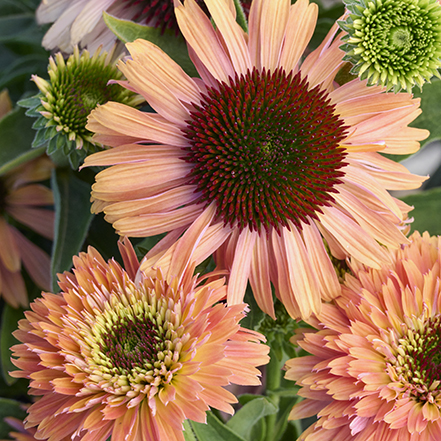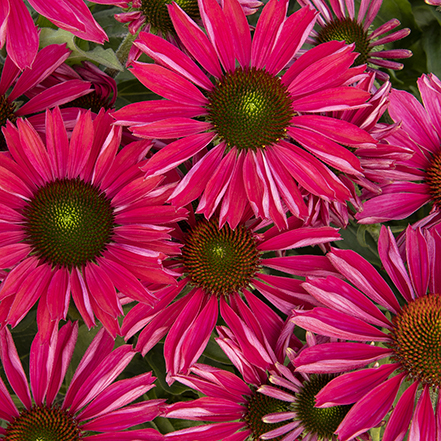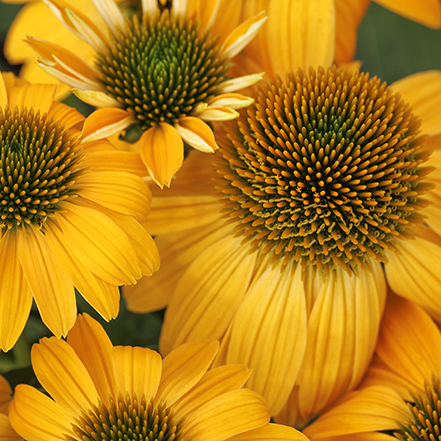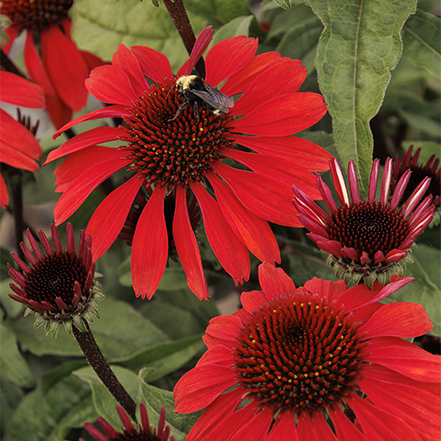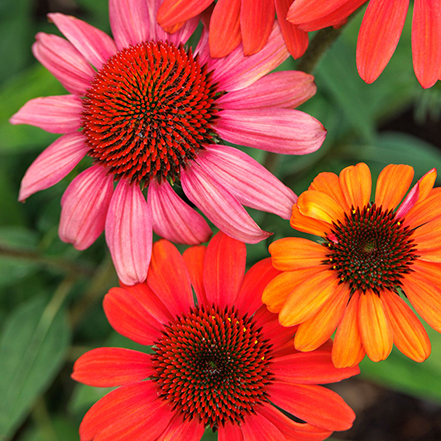Coneflower (Echinacea) is a beloved perennial known for its easy care and constant supply of blooms. Coneflowers are part of the daisy family (Asteraceae) and are a wildflower native to North America — no wonder they grow in so many different environments!
Whether you want to attract pollinators or add low-maintenance beauty to your garden, coneflowers do it all. Here, we will walk you through everything you need to know about their care, offer coneflower design ideas, and provide a list of some of the best-performing Coneflower varieties.
All About Coneflowers: Background and Characteristics
(Above) Evolution™ Fiesta Coneflowers bloom prolifically in a border with lavender in the background.
"Coneflower" is the common name for Echinacea purpurea and other Echinacea species. Native to North America, this plant is well known for its hardy nature and vibrant flowers that often feature a distinct spiky, cone-shaped center surrounded by petal rays.
There are a vast amount of coneflower varieties grown for home gardens, and a rainbow of coneflower colors. Monrovia selects only the best, testing and trialing for performance, color, hardiness, adaptability, and growth habit. About 40 varieties have been selected by Monrovia craftsmen to brighten your garden, from the yellow pop of the Evolution Embers Sparks Coneflower to the romantic hues of our Sombrero Salsa Red Coneflower. Find more of the top-performing coneflowers below.
Coneflowers are a favorite flowering perennial in America for the following reasons:
- Pollinator Plants: Coneflowers and their daisy-like blooms attract hummingbirds, butterflies, bees, and other friendly pollinators.
- Resilient and Easy to Grow: These plants are drought-resistant and easy to grow. Coneflowers are extremely hardy and thrive in USDA hardiness zones 4-9, depending on the variety.
- Colorful Blooms: Not only do coneflowers come in brilliant colors, but their varieties also bloom at different times. If you plant strategically, you can have coneflower blooms for up to 5 months, adding vibrancy to your garden from May to September.
How To Plant and Grow Coneflowers
Once you've chosen the right varieties for your landscape, it's time to get planting!
Selecting the Right Location for Your Coneflowers
Plant coneflowers where they will get 6-8 hours of sun each day. Partial shade is good if you live in a warmer region (zones 8 and higher), as it will keep your coneflowers from fading. These flowers flourish in well-drained soil and are tolerant of a range of soil types, although they prefer soil rich in organic matter.
How to Plant Your Coneflowers
The best time to plant Coneflowers is in the spring once the threat of frost has passed. To plant your coneflowers:
- Dig a hole twice the size of the pot. Chop up the sides and bottom of the hole, then backfill it with some compost.
- Remove your coneflower from the pot and tease its roots to loosen, then place the roots in the hole.
- Backfill the hole with soil and compost. Make sure you keep the crown above ground level.
- Finally, apply a thin layer of mulch (be careful not to smother the stems) and water your coneflower immediately.
Proper Watering and Fertilizing Techniques
After planting, water your coneflowers immediately, and then check them every other day. If the top inch of their soil is dry, water them. Look out for droopy leaves, as these are a sign of thirsty coneflowers. Coneflowers are drought tolerant once established, so once they've been in your flower garden for an entire growing season, you won't need to water them unless it hasn't rained for a month or more.
Fertilizer is generally not necessary for coneflowers, especially if they're planted in high-quality soil. But, if necessary, you can add a bit of fertilizer or compost during late winter or early spring.
Winter Care for Coneflowers
Coneflowers don't need much winter care. It's best to let them stand during most of the winter to provide food for birds. Then, in late winter, you can cut them back to the ground. In early spring, leaves will emerge at ground level, followed by flower stalks.
How and When to Prune Your Coneflowers
Although deadheading flowers to make space for repeat blooming is a popular practice, many coneflower varieties will be just fine when left alone. If your coneflowers bloom consistently, let them be and give some food to the wildlife. Birds go crazy for coneflower seeds!
Once your coneflowers are finished blooming, just let them sit. At the end of winter, cut them back to the ground before new growth begins. To prune your coneflowers, use clean, sharp pruners to remove spent flowers or any dead or damaged stems.
Garden Design Ideas with Coneflowers
Coneflowers are a versatile and vibrant addition to garden design. They provide continuous interest from mid-summer to fall, and their hardy nature makes them ideal for a range of garden settings, thriving in both formal flower beds and more naturalistic prairie-style gardens. Coneflowers attract pollinators such as bees and butterflies, making them perfect for pollinator gardens. Get a few coneflower design ideas below, and find even more inspiration in the pollinator section of the blog.
Swaths of coneflowers planted en masse are perfect for adding a big pop of summer-long color to beds and borders. Here, Evoluton™ Fiesta Coneflowers add a punch of red to the cool greens of grasses and shrubs.
Achieve a dreamy, enchanting garden with the soft pinks of Evolution™ Colorific™ Coneflower and plants that play with light in exciting ways, like Lamb's ear, Blonde Ambition blue grama grass, pink muhly grass, and Artemesia. See this garden and more in this Design School story.
Evolution™ Colorific™ Coneflower, Sombrero® Salsa Red Coneflower, and Northwind Switchgrass make a gorgeous pollinator-friendly container combo. See more pollinator container garden ideas here.
Best Coneflowers for Low-Maintenance Color
Evolution™ Colorific™
Coneflower
Each bloom features an enchanting green cone, matching the leaves in color, framed by dense petals in a lovely palette of pink hues. The lush foliage and sturdy, upright stems create a beautiful backdrop for the continuous profusion of flowers from late spring through fall. Stunning in beds, borders, and containers. Full sun. Up to 20" tall, 18" wide. Zones 4-9.
Fresco® Apricot
Coneflower
Large frilly double flowers in pink and apricot hues top long stems from summer through fall. Their tall, narrow habit is perfect for tucking into perennial borders among other flowering perennials and ornamental grasses. These vibrant blooms are also loved by pollinators. Full sun. Up to 23" tall, 20" wide. Zones 4-9.
Kismet® Raspberry
Coneflower
This naturally compact, easy-care perennial is adorned with an abundance of raspberry-pink flowers. Blooming earlier than most, it continues to display its vibrant colors until the first frost, with each flower lasting for weeks. Perfect for the front of sunny borders, meadow gardens, or container plantings, it adds long-lasting beauty to any garden setting. Full sun. Up to 18" tall, 24" wide. Zones 4-9.
Sombrero® Granada
Gold Coneflower
A profusion of rich, golden yellow, large single blooms will beautifully adorn a sunny border or cutting garden from late spring through summer. This sturdy variety is bred for cold hardiness and a compact form, offering prolific flowering over an exceptionally long season. Full sun. Up to 22" tall, 24" wide. Zones 4-9.
Panama™ Red
Coneflower
Enjoy deep red flowers with dark centers on this short and compact variety, blooming over an extended season. Perfect for wildlife gardens, it attracts butterflies, hummingbirds, bees, and birds. Its smaller size also makes it ideal for containers. Full sun. Up to 14" tall and wide. Zones 5-9.
Evolution™ Fiesta
Coneflower
Fiesta delivers a riot of color with spicy coral-pink flowers that gradually soften as they age. New blooms emerge throughout summer, ensuring a lively display. Essential for cutting gardens and perfect for containers or borders. Full sun. Up to 20" tall, 18" wide. Zones 4-9.
Common Diseases and Pests that Affect Coneflowers
Coneflowers are generally very resilient, but they can still occasionally face a few diseases and pests. Here's what to watch out for (and how to treat it):
Powdery Mildew
Powdery mildew appears as a white, powdery substance on the surfaces of leaves and stems. It thrives in warm, humid conditions. Proper plant care can help prevent this disease. You can improve air circulation around the plants by spacing them properly and avoiding overcrowding. Wet leaves can also exacerbate the problem. Avoid overhead watering if possible. If using overhead irrigation, water in the early morning so the leaves can dry in the morning sun. If you spot this disease, remove and destroy infected plant parts immediately. If needed, find a fungicidal spray with sulfur or potassium bicarbonate and apply it according to label instructions.
Aster Yellows
Aster yellows is caused by phytoplasma and lead to distorted growth, yellowing of leaves, and abnormal flower development. Unfortunately, there's no cure for aster yellows; any infected plants should be removed immediately to prevent further spread. You can control the leafhoppers that spread this disease using insecticidal soap or neem oil. Aster yellows is common in some parts of North America, but uncommon in others.
Japanese Beetles
Japanese beetles are metallic green beetles that skeletonize leaves and flowers by feeding on them. If you spot Japanese beetles on your coneflowers, handpick them from the plants early in the morning (when they are less active) and drop them in soapy water. Or, use insecticidal soap or neem oil to control them. For a natural remedy, planting repellent plants like garlic or chives nearby can help deter Japanese beetles from feeding on your coneflowers.
Commonly Asked Questions about Coneflower Care
Do coneflowers spread?
Coneflowers naturally grow in clumps and don't spread as much as other perennials, but you will get a gradual expansion. Older varieties will self-seed if their blooms are left alone, which is a great way to get more plants. Many newer varieties are sterile to encourage more blooms and will not spread by seed.
Where do coneflowers grow best?
Coneflowers thrive best in areas with well-drained soils and full sun to partial shade. They are particularly adaptable and hardy, making them suitable for growth nearly anywhere in USDA hardiness zones 4 through 9. To maximize their growth and flowering, planting them in a location that receives at least 6 hours of sunlight daily is ideal, with some afternoon shade being beneficial in hotter climates.
Should you deadhead coneflowers?
Removing spent blooms (a.k.a. deadheading) is not necessary, but it can be helpful if you want to promote increased blooming throughout the season. Leaving spent flowers on the plant in late summer and fall provides seeds that attract and feed birds. Plus, these old blooms can also add winter interest to your garden.
How do you keep coneflowers blooming?
To keep coneflowers blooming, make sure they are planted in a location with at least 6 hours of sunlight and well-draining soil. You can try regularly deadheading your coneflowers to encourage more blooms.
Also, make sure you give them adequate water during dry periods. If your coneflowers are growing in low-nutrient soil, try a balanced, slow-release fertilizer in the early spring to support sustained blooming during the growing season.
Get More Plant Care Tips and Guides
- Sign up for the Grow Beautifully Newsletter. You'll get gardening tips, design advice, free digital guides, and live webinar invites. Plus, new, exclusive plant information delivered straight to your inbox twice a month.
- Hibiscus Care Guide
- Conifer Care Guide
- Boxwood Winter Care
- Azalea Care Guide
- Hydrangea Care Guide
- Top 10 Tips for Planting in Summer
- How to put Hydrangeas to Bed for Winter
- Our Top 10 Gardening Tips
- Guide to Pruning Flowering Shrubs
- How and When to Prune Hydrangeas
- Pruning Ornamental Grasses
- How and When to Prune Lavender
- Check out the "Garden Tips" section of the blog. Here there are care guides and garden tips on a wide array of plants.





